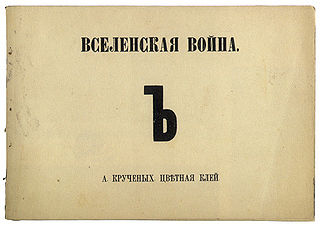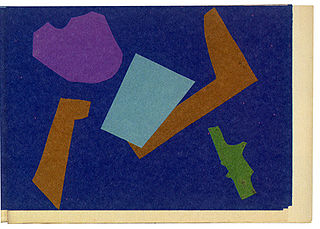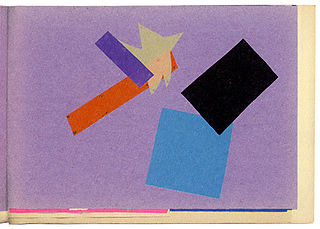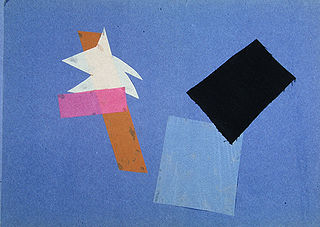
Universal War
Encyclopedia

Aleksei Kruchenykh
Aleksei Eliseevich Kruchenykh or Kruchonykh or Kruchyonykh , a well-known poet of the Russian "Silver Age", was perhaps the most radical poet of Russian Futurism, a movement that included Vladimir Mayakovsky, David Burliuk and others. Together with Velimir Khlebnikov, Kruchenykh is considered the...
published in Petrograd at the beginning of 1916. Despite being produced in an edition of 100 of which only 12 are known to survive, the book has become one of the most famous examples of Russian Futurist
Russian Futurism
Russian Futurism is the term used to denote a group of Russian poets and artists who adopted the principles of Filippo Marinetti's "Manifesto of Futurism"...
book production, and is considered a seminal example of avant-garde
Avant-garde
Avant-garde means "advance guard" or "vanguard". The adjective form is used in English to refer to people or works that are experimental or innovative, particularly with respect to art, culture, and politics....
art from the beginning of the twentieth century.
Published at the height of Russian involvement in World War I
World War I
World War I , which was predominantly called the World War or the Great War from its occurrence until 1939, and the First World War or World War I thereafter, was a major war centred in Europe that began on 28 July 1914 and lasted until 11 November 1918...
(see Gorlice-Tarnów Offensive
Gorlice-Tarnów Offensive
The Gorlice–Tarnów Offensive during World War I started as a minor German offensive to relieve Russian pressure on the Austro-Hungarians to their south on the Eastern Front, but resulted in the total collapse of the Russian lines and their retreat far into Russia...
), the book attempts to echo the chaos and destruction of the war with the chaos and disruption of collage techniques new to the Russian Avant-Garde at the time, and opens with the bleak prophecy "Universal War will take place in 1985". Shortly after the book was published, Kruchenykh left Petrograd to live in a hut in the Caucausus to avoid the draft.
"One of the most outstanding merits of the album- a dadaist work in the fullest sense- is its successful realization of Kruchenykh's concept of collage as an artistic method transcending mere technique and capable of metaphorically expressing the 'discordant concordance' of the age."
The book is an early attempt to link zaum
Zaum
Zaum is a word used to describe the linguistic experiments in sound symbolism and language creation of Russian Futurist poets such as Velimir Khlebnikov and Aleksei Kruchenykh....
poetry (often translated as 'transrational' or 'beyonsense' poetry) with 'zaum' images. In the foreword, Kruchenykh refers to the book as 'Poetic zaum shaking the hand of the pictorial zaum'.
Universal War is often erroneously credited as a collaboration between Kruchenykh and his wife, the artist Olga Rozanova
Olga Rozanova
Olga Vladimirovna Rozanova Olga Vladimirovna Rozanova Olga Vladimirovna Rozanova (also spelled Rosanova, Russian: (Ольга Владимировна Розанова) (1886-7 November 1918, Moscow) was a Russian avant-garde artist in the styles of Suprematist, Neo-Primitivist, and Cubo-Futurist.-Biography:...
. Whilst the pair often collaborated on artist's books-including A Game In Hell (1914) and Transrational Boog (1915)- most authorities now consider the work to be by Kruchenykh alone. A series of similar collages - also credited to Kruchenykh - in the book 1918 was published in Tiflis (Tbilisi) in January or February 1917, whilst Rozanova was still in Moscow
Moscow
Moscow is the capital, the most populous city, and the most populous federal subject of Russia. The city is a major political, economic, cultural, scientific, religious, financial, educational, and transportation centre of Russia and the continent...
and the Verbovka Village Folk Centre
Verbovka Village Folk Centre
Verbovka Village Folk Centre was an artisan cooperative in the village of Verbovka founded by Natalia Davidova in the Ukrainian province of Kiev...
working for Malevich and, later, Izo Narkompros.
The emergence of Russian futurist books

Succès de scandale
Succès de scandale is French for "success from scandal", i.e. when a success derives from a scandal.It might seem contradictory that any kind of success might follow from scandal: but scandal attracts attention, and this attention is sometimes the beginning of notoriety and/or other successes...
that helped to establish Futurism
Futurism
Futurism was an artistic and social movement that originated in Italy in the early 20th century.Futurism or futurist may refer to:* Afrofuturism, an African-American and African diaspora subculture* Cubo-Futurism* Ego-Futurism...
in Russia. He left Gileia in 1912 to join the rival Donkey's Tail
Donkey's Tail
Donkey's Tail was a Russian artistic group created from the most radical members of the Jack of Diamonds group. The group included such painters as: Mikhail Larionov , Natalia Gontcharova, Kazimir Malevich, Marc Chagall, and Alexander Shevchenko. The group was influenced by the Cubo-Futurism...
group. Each of the members would collaborate with Kruchenykh on his next three artist's books; A Game In Hell, Worldbackwards and Old-Time Love. These three publications set the tone for a radical deconstruction of the book format:
"If Kruchenykh had consciously set out to dismantle (nowadays we might say "deconstruct") the legacy of Johannes Gutenberg, it is unlikely that he could have done it more completely....In a series of remarkable book works of 1912 to 1920, Kruchenykh and his collaborators challenged this legacy in an unprecedentedly complete way, step-by-step departing from our European expectations about what a twentieth century book should be," Gerald Janecek
Universal War in Russian literature
Universal War was an atypical book for Kruchenykh, since despite training as an artist, he usually only supplied the poetry for his books. This allowed collaborating artists such as Natalya GoncharovaNatalia Goncharova
Natalia Sergeevna Goncharova was a Russian avant-garde artist , painter, costume designer, writer, illustrator, and set designer. Her great-aunt was Natalia Pushkina, wife of the poet Alexander Pushkin.-Life and work:...
, Kazimir Malevich
Kazimir Malevich
Kazimir Severinovich Malevich was a Russian painter and art theoretician, born of ethnic Polish parents. He was a pioneer of geometric abstract art and the originator of the Avant-garde Suprematist movement.-Early life:...
and Rozanova unusual levels of freedom to integrate their pictures with his hand-written words. Universal War featured his own collages, in an abstract style Kruchenykh referred to as 'Non-Objective'. The series of collages run parallel to the poetry printed on the first two sheets. Germany is depicted as a belligerent spiky helmet with its shadow, a black panther, fighting Russia.
The book starts with two pages of poems, under the headline "Universal War will take place in 1985" with page references to associate them with specific images. These poems are followed by 12 related collages, consisting of coloured sheets of card-mostly dark blue, but interspersed with grey, white and pink sheets- with various other papers and fabrics stuck to the sheets. Whilst the copies are similar, they show subtle differences.
Poetic and pictorial Zaum


Filippo Tommaso Marinetti
Filippo Tommaso Emilio Marinetti was an Italian poet and editor, the founder of the Futurist movement, and a fascist ideologue.-Childhood and adolescence:...
insistence on the concrete
Concrete poetry
Concrete poetry or shape poetry is poetry in which the typographical arrangement of words is as important in conveying the intended effect as the conventional elements of the poem, such as meaning of words, rhythm, rhyme and so on....
nature of words, Kruchenykh insisted that Zaum was a liberation from meaning as well as form.
[Kruchenykh] described the new logic of zaum as ‘broader than sense’, a logic that liberated words, letters and sounds from their ‘submission to meaning’ as defined by conventional three-dimensional logic.
The poems are short, and are filled with onomatopeiac syllables;
Page 2—Battle Between Mars and Scorpio
appetite pegasus
appendicitus
grabz
chachen
respact
herself
female
tuningfork
Page 3—Explosion of a Trunk
with the queue full of whips
cuts the stone with vengeance
hil ble faes
och fi ge
In the preface Kruchenykh claimed that the collages were born of the same source as transrational language- 'the liberation of creation from unnecessary conveniences (through non-objectiveness)'. He cited the style as originating with Rozanova, and taken up by Malevich under 'the rather uninformative name' of Suprematism
Suprematism
Suprematism was an art movement focused on fundamental geometric forms which formed in Russia in 1915-1916. It was not until later that suprematism received conventional museum preparations...
. In fact, the Russian avant-garde were well aware of Kandinsky's
Wassily Kandinsky
Wassily Wassilyevich Kandinsky was an influential Russian painter and art theorist. He is credited with painting the first purely-abstract works. Born in Moscow, Kandinsky spent his childhood in Odessa. He enrolled at the University of Moscow, studying law and economics...
experiments with Abstract art
Abstract art
Abstract art uses a visual language of form, color and line to create a composition which may exist with a degree of independence from visual references in the world. Western art had been, from the Renaissance up to the middle of the 19th century, underpinned by the logic of perspective and an...
. Kandinsky, a Russian living in Munich, regularly returned to Russia, and had contributed to A Slap In The Face Of Public Taste with a poem from Klänge, an artist's book of sound poetry placed in tandem with abstract woodcuts, published in Munich, 1912. Another seminal artist's book, La prose du Transsibérien et de la Petite Jehanne de France
La prose du Transsibérien et de la Petite Jehanne de France
La prose du Transsibérien et de la Petite Jehanne de France is a collaborative artists' book by Blaise Cendrars and Sonia Delaunay-Terk...
by Blaise Cendrars
Blaise Cendrars
Frédéric Louis Sauser , better known as Blaise Cendrars, was a Swiss novelist and poet naturalized French in 1916. He was a writer of considerable influence in the modernist movement.-Early years:...
and another Russian, Sonia Delaunay
Sonia Delaunay
Sonia Delaunay was a Jewish-French artist who, with her husband Robert Delaunay and others, cofounded the Orphism art movement, noted for its use of strong colours and geometric shapes. Her work extends to painting, textile design and stage set design...
, had been exhibited in Russia in late 1913, and similarly linked colourful abstract images with concrete poetry.
The work pre-dates Hans Arp's similar experiments with abstract collages done for the Cabaret Voltaire
Cabaret Voltaire (Zürich)
Cabaret Voltaire was the name of a nightclub in Zurich, Switzerland. It was founded by Hugo Ball, with his companion Emmy Hennings on February 5, 1916 as a cabaret for artistic and political purposes. Other founding members were Marcel Janco, Richard Huelsenbeck, Tristan Tzara, and Jean Arp...
, an early Dada
Dada
Dada or Dadaism is a cultural movement that began in Zurich, Switzerland, during World War I and peaked from 1916 to 1922. The movement primarily involved visual arts, literature—poetry, art manifestoes, art theory—theatre, and graphic design, and concentrated its anti-war politics through a...
venue, although it's not known if the two men were aware of each other's works.
Exile
Unlike the Italian futurists, the attitude of the Russian futurists to the war and the Russian RevolutionOctober Revolution
The October Revolution , also known as the Great October Socialist Revolution , Red October, the October Uprising or the Bolshevik Revolution, was a political revolution and a part of the Russian Revolution of 1917...
were at best ambiguous- Kruchenykh, like Kamensky
Vasily Kamensky
Vasily Vasilevich Kamensky was a Russian Futurist poet, playwright, and artist as well as one of the first Russian aviators.Kamensky was born in the Perm district, where his father was an inspector of goldfields...
, dodged the draft by retiring to a wooden hut in the Caucausus sometime in 1916. By 1917, he had moved to the newly independent (if short-lived), menshevik
Menshevik
The Mensheviks were a faction of the Russian revolutionary movement that emerged in 1904 after a dispute between Vladimir Lenin and Julius Martov, both members of the Russian Social-Democratic Labour Party. The dispute originated at the Second Congress of that party, ostensibly over minor issues...
-controlled Democratic Republic of Georgia
Democratic Republic of Georgia
The Democratic Republic of Georgia , 1918–1921, was the first modern establishment of a Republic of Georgia.The DRG was created after the collapse of the Russian Empire that began with the Russian Revolution of 1917...
, and became a member with Ilia Zdanevich
Ilia Zdanevich
Ilia Mikhailovich Zdanevich , known as Iliazd , was a Georgian and French writer and artist, with the Dada movement....
and Igor' Terent'ev of the avant-garde
Avant-garde
Avant-garde means "advance guard" or "vanguard". The adjective form is used in English to refer to people or works that are experimental or innovative, particularly with respect to art, culture, and politics....
group 41°, centered at the Fantastic Cavern, an underground cabaret in downtown Tiflis
Tbilisi
Tbilisi is the capital and the largest city of Georgia, lying on the banks of the Mt'k'vari River. The name is derived from an early Georgian form T'pilisi and it was officially known as Tiflis until 1936...
. The scattering of artists during the revolution effectively brought Cubo-Futurism
Cubo-Futurism
Cubo-Futurism was the main school of painting and sculpture practiced by the Russian Futurists.When Aristarkh Lentulov returned from Paris in 1913 and exhibited his works in Moscow, the Russian Futurist painters adopted the forms of Cubism and combined them with the Italian Futurists'...
to an end, to be replaced by constructivism
Constructivism (art)
Constructivism was an artistic and architectural philosophy that originated in Russia beginning in 1919, which was a rejection of the idea of autonomous art. The movement was in favour of art as a practice for social purposes. Constructivism had a great effect on modern art movements of the 20th...
.
There are copies of Universal War in MOMA
Moma
Moma may refer to:* Moma , an owlet moth genus* Moma Airport, a Russian public airport* Moma District, Nampula, Mozambique* Moma River, a right tributary of the Indigirka River* Google Moma, the Google corporate intranet...
, New York, and in the Costakis collection
George Costakis
In the years surrounding the 1917 revolution, artists in Russia produced the first non-figurative art, which was to become the defining art of the 20th century...
.
External links
- Almost the whole of Universal War online at MOMA Online
- The poems translated by Jack Hirschman, Alexander Kohav & Venyamin Tseytlin
- A Game In Hell, second edition 1914, by Kruchenykh, Malevich and Rozanova
- A Little Duck's Nest . . . of Bad Words, An artist's book by Rozanova and Kruchenykh, 1913, + brief biography
- Transrational Boog by Kruchenykh and Rozanova, 1915
- A whole series of Russian Avant-Garde books online at Getty Archives, including Transrational Boog and A Game In Hell

